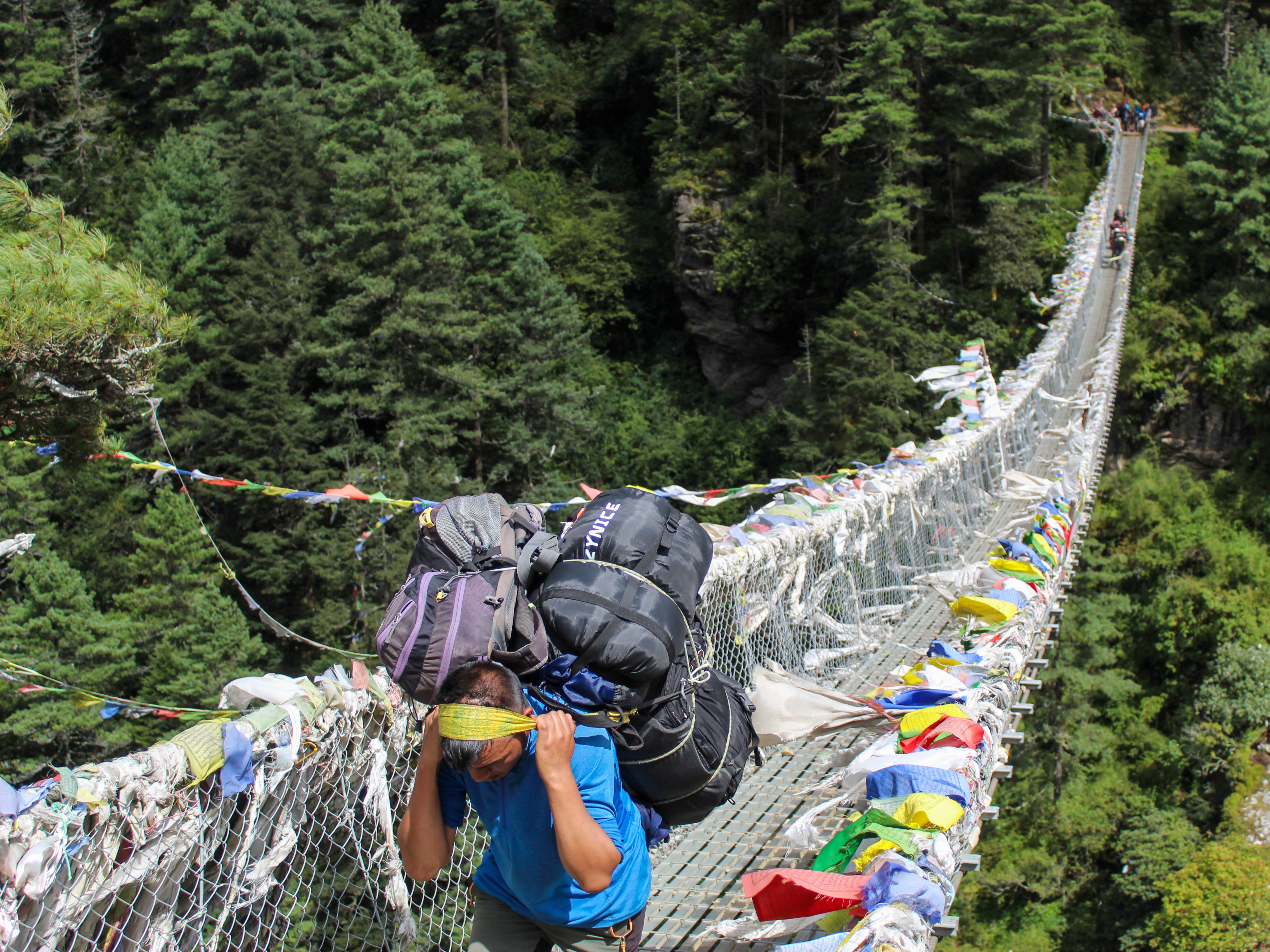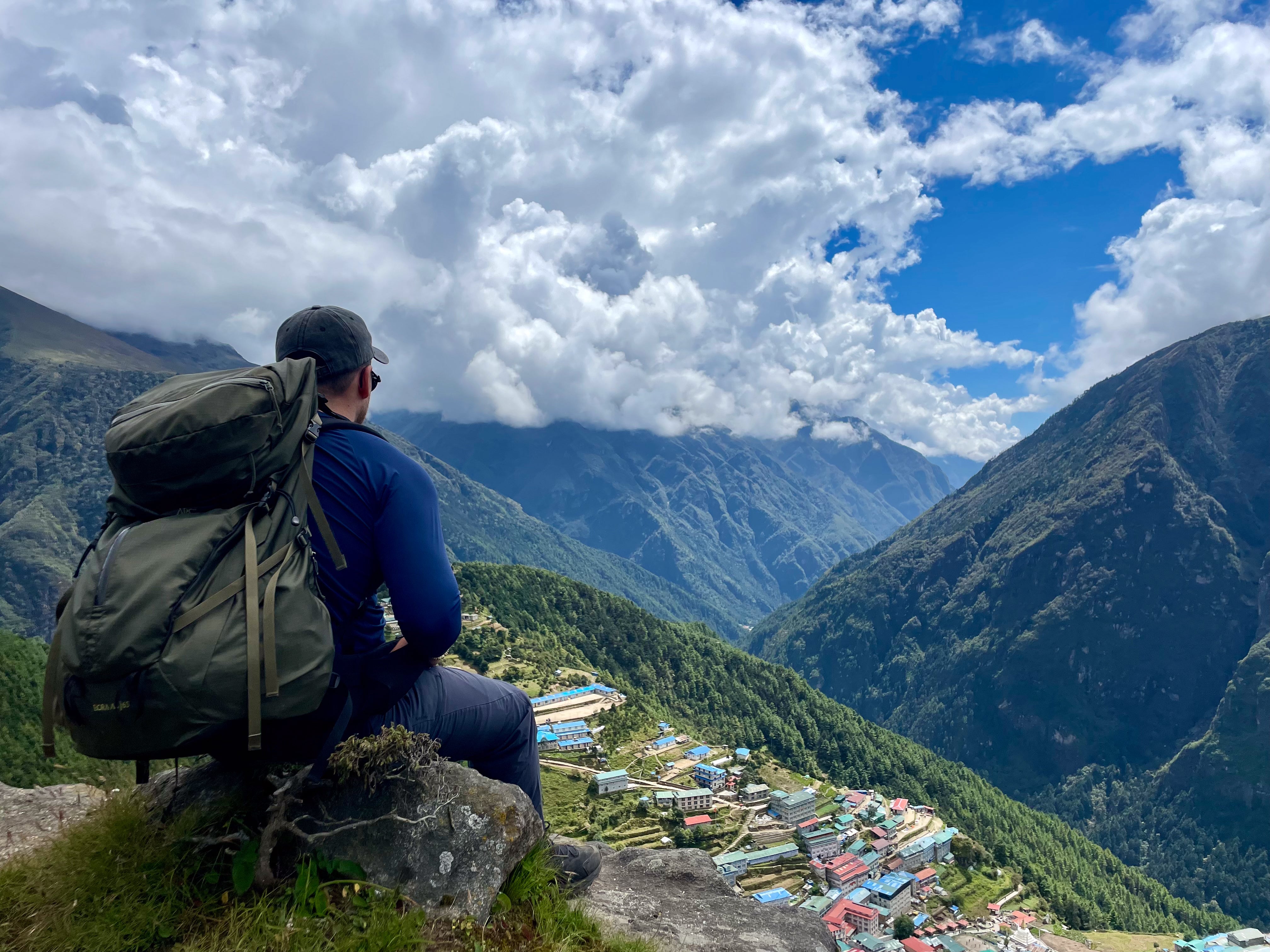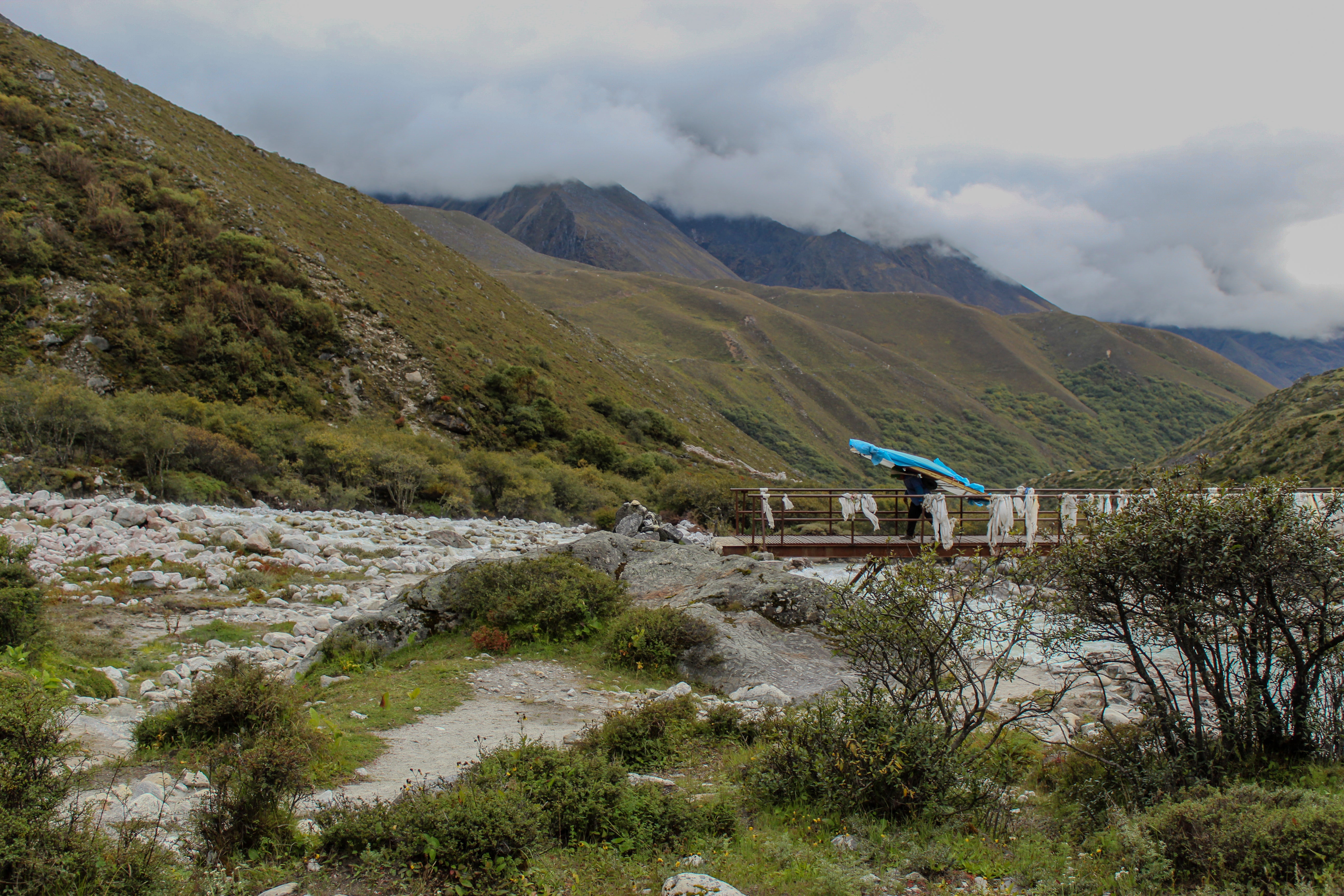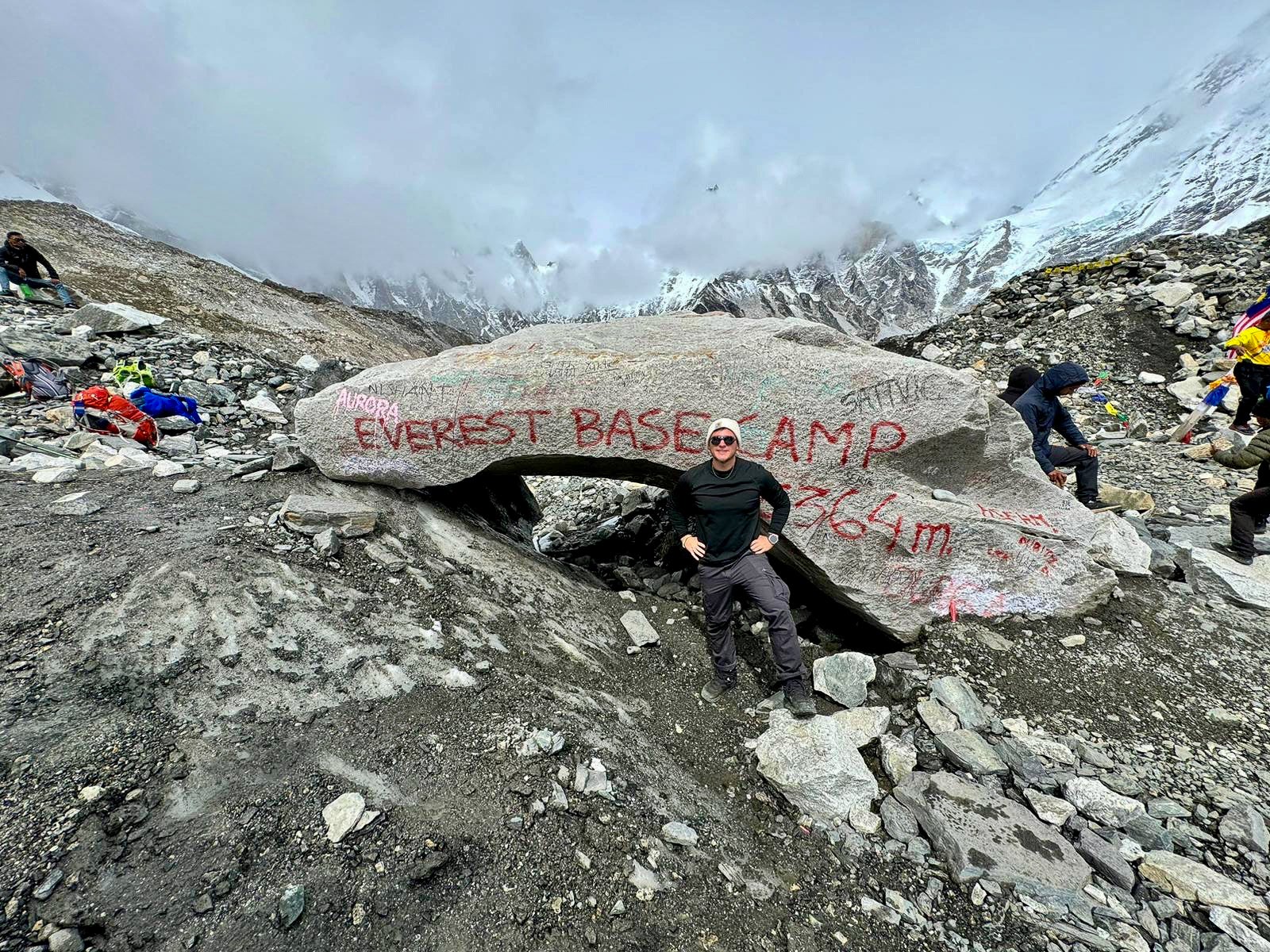The short flight from Kathmandu to Lukla offers the first true sense of the expedition’s scale. Stretching for thousands of miles in each direction, the breathtaking vistas of the Himalayas deliver an ominous glimpse into the thrilling terrain awaiting the 12 of us, who have arrived from across the globe with one shared ambition.
Through one of the few small windows of our twin-engined aircraft, we witness vast rolling hills and frozen waterfalls etched into the face of the Khumbu Valley, where, very soon, we will be trekking to our ultimate destination: Everest Base Camp, some 5,364m above sea level.
However, before we begin our ascent, first we must navigate Lukla’s airport. Home to the world’s shortest runway, the 527m landing strip slopes steeply down the side of a cliff and marks the gateway to the Everest region.
Each year it welcomes hundreds of thousands of climbers, trekkers and thrillseekers in search of adventure. But beyond being an extreme adventure playground, there is a growing tension at the heart of Everest. Reports emerge each season of overcrowding at the summit and plastic pollution across the ranges. Distressing stories of climbers dying due to long queues in the notorious “death zone” are remarkable now only for their predictability.
Meanwhile, tales of luxury goods such as hot tubs, flatscreen TVs, electric heaters and coffee machines carried to the peak by privately hired local porters are all too familiar within the climbing community. Porters who are all too quickly erased from the stories of climbers basking in the glory of their successful expeditions.
With that in mind, I’ve also come to see how this region – which remains sacred to the Indigenous Nepali and Tibetan communities living at high altitudes – exists alongside the booming adventure tourism industry that brings both income and aggravation to this stunning region.
I am travelling with Intrepid, a tour company known for its strong connections in the region and its commitment to using tourism as a force for good. Leading our expedition is Sumitra, a 32-year-old climber already building a reputation in the Himalayas.
Accompanying her are two energetic assistants and a supporting crew of six porters. Their role is to carry the group’s excess baggage, leaving earlier and covering the distance more quickly than us. Our guides, who are well compensated for their efforts, ensure that everything is in place when we reach each stage of our trek.
A walk among giants
In the cosy confines of a Lukla teahouse, the 120km trek among giants is laid out before us. Twelve days of walking, up to eight hours a day, will take us from the lush green trails of Phakding (2,610m) to the agricultural terraces of Phortse (3,810m), the beautiful expanse of Dingboche (4,410m), and the barren, windswept landscape of Gorak Shep (5,160m). The journey will culminate with the final march to the imposing Everest Base Camp.

Our first major stop is at 3,440m above sea level. If Everest is both a hub of spiritualism and a centre of commerce, no place better represents this dichotomy than Namche Bazaar. The clang of bells attached to prayer wheels rings out loudly outside the world’s highest Irish pub, where a can of Guinness will set you back 1,000 Nepalese rupees (roughly £6).
Once a historic trading post where Tibetan sherpas bartered salt, wool, and livestock for rice, grains, and other essentials from the lower regions of Nepal, Namche Bazaar now offers an endless array of climbing equipment alongside typical tourist goods. Today, you’ll find posh coffee shops and restaurants serving Mexican, Japanese, Indian, and Italian fare.
It is near Namche Bazaar, in front of a 3D model of the Khumbu region, where early in the trek Sumitra holds court and points out the summits of the region: Everest stands at 8,849m (the Nepalese call it Sagarmatha, the Tibetans, Chomolungma), Nuptse (7,861m), and Thamserku (6,608m). So impressive is her knowledge that other groups and solo travellers stop and listen to her lecture.
But Sumitra is more than just an expert in Everest’s topography – she’s a true Himalayan mountaineer, deeply connected to the region and its people. As we travel, we discuss the area’s growing pains and come to one clear observation: no porters, no industry. These men are the lifeblood of the region, and without them, Everest herself would undoubtedly remain unconquered.

Yet, as we hike through the national park, it’s not just oxygen bottles and essential equipment that we see being carried along the trails. The back-breaking loads also include crates of Coca-Cola hauled up the rocky terrain, along with snooker tables, doors and a surprising array of luxuries more commonly found on the high street.
Sumitra tells me: “This isn’t even the busy season yet. If you go to Base Camp in spring you see green carpets, fancy tables, TVs, refrigerators, big heaters. You can get anything you’re willing to pay for. It used to be an adventure, but now it’s become a luxury for people with lots of money.”
The sight of these men, many of whom are wearing sandals or cheap boots, lugging astonishing weights using rope lashed to their foreheads, while just one misplaced foot away from a sheer, certainly fatal drop, is deeply sobering.
“I see men aged up to 60 in simple flip-flops carrying more than 90kg loads,” says Sumitra. “I think, that could be someone’s dad or husband. I once saw a man who was between 65 and 70 doing the trek barefoot with around 80kg of load walking through snow and water.”
She explains that these private porters are paid per kilogram and kilometre. Therefore the heavier the load, over a longer distance, the greater the pay. The system feels rigged and oppressive.
“It works both ways”, explains Sumitra. “If there isn’t demand then some of the local people would not have jobs. But equally, if there was less demand then we would have less plastic pollution, which is one of the biggest problems on the mountain now.

We agree that when you choose to be an adventurer, you shouldn’t expect the comforts of home. Especially when the porters who do the carrying aren’t valued, which is what Intrepid is trying to change. The men are paid properly and the group are expected to tip them and then, says Sumitra, “we throw a party at the end as thanks. We give them comfortable lodgings and encourage them to practise English and public speaking with the group.
“I started as a porter and now I’m an expedition leader. But if it’s a private porter, they work from hotel to hotel, or company to company, often they don’t have this path.”
People can’t climb without sherpas. Everything they achieve is with the help of sherpas but the name of sherpas is never given the fame
Sumitra’s solution is a simple one. Recognising that the whole place would grind to a halt without porters, she calls for local government to bring in regulations for maximum loads and fixed rates, alongside subsidised costs of meals so that they do not have to pay tourist prices.
To Base Camp
From the village of Dingboche, we ascend a small ridge above the Pheriche Valley, leaving the treeline behind. The skies are clear, and the summits of Taweche and Cholatse (6,440m) rise in the distance. Compared to previous days, the morning’s climb is relatively easy, with just a few hundred metres of ascent – affectionately known as a “Nepalese flat”. But this is merely a warm-up for the terminal moraines of the Khumbu Glacier, waiting ahead.
Buoyed by tales of Everest legends – George Mallory, Sir Edmund Hillary, Sherpa Tenzing, and their pioneering Nepali porters – I decide to double my load and carry a lagging team member’s bag on a 90-minute climb into the clouds. But, I make a crucial mistake: I forget to add layers as the temperatures start to plummet.
It was a rookie error, and Everest punishes me accordingly. This is a harsh region, and at altitude, with limited sleep, the immune system quickly weakens. To make the final ascent with a fever and fatigue it feels like, well… climbing Everest. Yet, the benefits of travelling with a group come to the fore once again, as I draw energy from them and focus on putting one foot in front of the other.

As the trail rises yet further, the path to Base Camp transforms completely. The lush greenery gives way to a rocky, barren landscape that feels almost otherworldly. The mountain tops, striking in their distant beauty, become dusty and dangerous as we trudge onward. Our deep breaths are punctuated by the eerie crick-crack of rocks tumbling above and the faraway powdery bellow of avalanches.
After several more gruelling hours we finally complete the last undulating stretch of loose stones and reach the iconic Base Camp boulder. A wave of relief washes over me, lifting my spirits just long enough for a round of photos, hugging, and more photos. It’s a beautiful, jubilant moment – though the true scale of the achievement won’t fully sink in until hours later.
The life of sherpas
A day later, we meet Pemba Tshering Sherpa, a retired mountaineer with five Everest summits to his name. When asked about the draw of the mountain for him, his answer is unequivocal: “The money”.
Pemba Tshering Sherpa’s first ascent was at age 35 and his last at 47. After his fifth summit and worsening health, his family stopped him from risking his life again. In the boom of the Everest industry, Sagarmatha is losing its identity and the indigenous communities are being erased from the very tapestry they helped weave.
“People can’t climb without sherpas [mountain guides]. Everything they achieve is with the help of sherpas but the name of sherpas is never given the fame. It’s always the person who gets to the top but by paying money, you are allowed to lose the sherpa’s name and just document your own success. The person who guided you or helped you is not mentioned.”
Despite this, Pemba cannot hide his wonder at the sensation of being at the summit. “Everyone is so happy that they start crying, it’s always tears of happiness.”
However, he admits the joy is soon replaced by a sense of foreboding. “The top is always the happiest part but once you descend there is a fear about what is to come next.”
Pemba Tshering Sherpa’s warning about the dangers of the descent proves eerily prescient. As we depart, Everest delivers one final sting. Heavy rain lashes the valley as we descend nearly 3,000m in two days, bursting riverbanks and triggering landslides. Some 200 people in Kathmandu and in the Khumbu Valley lose their lives, helicopters are diverted for emergency rescues, and travellers are stranded at Lukla airport for days. It’s a stark reminder of the region’s volatility and the immense hardships faced by those who call the Himalayas home.







